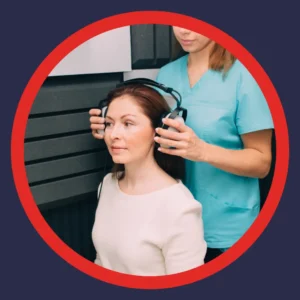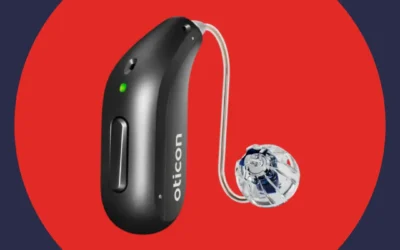October is National Protect Your Hearing Month, a reminder to learn how to protect your hearing in everyday life. Noise-induced hearing loss is common, but prevention is simple with the right habits.
Why Protecting Hearing Matters
Hearing shapes how we connect with people, places, and experiences. It lets us follow conversations, enjoy music, and respond to the world around us. When hearing declines, these connections become harder to maintain, and quality of life often suffers.
Noise-induced hearing loss is both common and preventable. Loud music, power tools, and even daily commutes can expose ears to harmful levels of sound. Once damage occurs, it is usually permanent. This is why protecting hearing early and consistently is essential.
Age also plays a role. About one in three adults between 65 and 74 have hearing loss, and nearly half of adults over 75 experience it. Age-related changes in the inner ear combine with years of noise exposure, making older adults especially vulnerable. But prevention helps at every stage of life, not just later years.
Hearing loss also affects overall health. Research links untreated loss to social isolation, depression, and even cognitive decline. Protecting your hearing can help preserve memory, balance, and independence as you age.
Children and teens face risks as well. The rise of earbuds and portable devices has increased the risk of early hearing damage. The NIDCD launched the It’s a Noisy Planet. Protect Their Hearing® campaign in 2008 to help families learn safe listening habits. Lowering the volume, moving away from loud sounds, and wearing hearing protection are three proven strategies that can make a lifetime of difference.
At American Hearing + Audiology, we support this mission year-round. Through education, screenings, and advanced solutions, we help patients protect their hearing before problems arise. Learn more about National Protect Your Hearing Month and join the effort to keep hearing strong.

Simple Habits That Keep Ears Safe
Protecting hearing starts with everyday choices. Lowering the volume on personal devices is one of the easiest steps. Many smartphones now have built-in alerts that warn you when music is too loud. Listening at safe levels reduces your risk of lasting damage.
Distance matters as well. If you are near speakers at a concert or in front of loud machinery, take a few steps back. Even small changes in distance can cut noise exposure dramatically.
When sound is unavoidable, earplugs or noise-canceling headphones provide critical protection. Musicians, construction workers, and frequent travelers all benefit from using custom or high-quality protection. Gun enthusiasts should double up with both earplugs and earmuffs.
Learning the difference between temporary and permanent hearing loss helps too. If your ears ring after an event, damage has already started. That ringing is a sign your inner ear cells are stressed. Over time, repeated exposure can cause permanent loss. For more on causes and treatment, explore conductive vs sensorineural hearing loss.
How Loud Is Too Loud? Common Noise Levels
Knowing how loud is too loud makes it easier to protect your ears. Experts measure sound intensity in decibels (dB). The higher the dB, the less time it takes for damage to occur.
Here is a guide to common sounds and safe listening times:
|
Sound Source |
Decibel Level (dB) |
Safe Exposure Time |
|
Normal Conversation |
60 dB |
No risk |
|
Busy Street Traffic |
85 dB |
8 hours |
|
Lawnmower |
90 dB |
2 hours |
|
Concert or Sports Event |
100 dB |
15 minutes |
|
Chainsaw |
110 dB |
2 minutes |
|
Gunfire or Fireworks |
140 dB+ |
Immediate damage |
This chart shows why awareness matters. City traffic is safe for most of the day, but just 15 minutes at a concert can put your hearing at risk. Protecting your ears in these moments prevents long-term harm.

Eating for Stronger Hearing
The connection between diet and ear health is becoming clearer every year. Research shows that what you eat can influence how well you hear over time. A large NIH-supported study analyzed data from more than 71,000 women over two decades. Those whose diets most closely followed Mediterranean or DASH principles had about a 30 percent lower risk of hearing loss.
These dietary patterns share key features. They include vegetables, fruits, nuts, whole grains, legumes, and fish. They emphasize healthy oils, like olive oil, and limit sodium, sugar, and saturated fats. Together, these foods reduce inflammation, improve blood flow, and lower blood pressure—all essential for protecting delicate inner ear structures.
A systematic review in Frontiers in Nutrition supports these findings. The review highlighted several nutrients linked to healthier hearing, including:
- Omega-3 fatty acids
- Vitamin B2
- Carotenoids like beta-carotene and beta-cryptoxanthin
- Dietary fiber
- High-quality protein
These nutrients support the auditory system by reducing oxidative stress and maintaining healthy nerve signaling. The review also noted that diets rich in these foods may lower the risk of hearing loss caused by age or long-term noise exposure.
For a practical guide on which foods to include in your meals, see foods for hearing health. You can also review the original NIH study on diet and hearing.
Staying Active to Support Hearing
Exercise is equally important for preserving hearing. Regular physical activity increases circulation, which keeps the inner ear supplied with oxygen and nutrients. Without strong blood flow, the cochlea’s sensory hair cells are more vulnerable to damage.
Studies from the National Institute on Aging and Johns Hopkins University show a link between hearing loss and sedentary behavior. Adults with untreated hearing loss tend to be less active, which may speed up physical decline. In one study, participants with hearing loss were sedentary for about 34 minutes more per day compared to peers with normal hearing. Over time, this pattern can worsen both hearing health and overall well-being.
Light to moderate activities such as walking, swimming, or cycling improve cardiovascular health and may also benefit auditory function. Exercise lowers blood pressure and reduces stress, both of which are linked to better hearing outcomes. Learn more about the connection in our guide to hearing loss and exercise.
Daily Habits That Make a Difference
Hearing protection works best when it becomes routine. Small steps practiced consistently can safeguard your ears for decades. Here are essential habits to focus on:
|
Habit |
Why It Helps |
|
Lower device volume |
Prevents direct damage to inner ear cells |
|
Use earplugs in loud spaces |
Reduces exposure to harmful decibels |
|
Take listening breaks |
Allows auditory cells to recover |
|
Eat nutrient-rich foods |
Strengthens circulation and nerve function |
|
Exercise regularly |
Supports cardiovascular and auditory health |
|
Manage stress |
Helps reduce tinnitus risk |
|
Quit smoking |
Protects fragile hair cells from toxins |
|
Limit alcohol |
Prevents added strain on the auditory system |
|
Schedule hearing tests |
Identifies changes before they worsen |
When combined, these actions create a strong foundation for healthy hearing. Practicing them daily reduces your risk of preventable loss and supports lifelong communication.
Lifestyle Choices That Influence Hearing
Everyday choices influence how well hearing is preserved. Prolonged noise exposure remains the leading preventable cause of hearing loss. Concerts, power tools, and high-volume earbuds can all damage inner ear cells permanently. Once damaged, these cells do not grow back.
Other lifestyle risks include smoking, heavy alcohol use, poor nutrition, and unmanaged conditions like diabetes or high blood pressure. Each of these increases strain on circulation and weakens the body’s ability to protect delicate auditory cells. Stress is another factor, as it can worsen tinnitus and reduce quality of sleep, making it harder for the auditory system to recover.
Fortunately, many of these risks are manageable. Making conscious choices about daily habits can reduce the likelihood of long-term hearing decline.
Smart Lifestyle Practices for Protecting Hearing
- Keep the volume on personal devices below 60 percent.
- Use earplugs or earmuffs in noisy places, including concerts and sporting events.
- Take breaks from loud environments to give ears time to recover.
- Quit smoking and reduce alcohol consumption to support circulation.
- Manage blood pressure and diabetes with medical guidance.
- Reduce stress with regular exercise, meditation, or breathing exercises.
By turning these steps into consistent habits, you can create a strong defense against preventable loss.
Protecting Hearing for Children and Teens
Children and teens are at growing risk of hearing loss because of increased headphone use and noisy social environments. Safe listening habits during these years may prevent lifelong challenges.
The National Institute on Deafness and Other Communication Disorders created the “It’s a Noisy Planet. Protect Their Hearing®” campaign to highlight prevention strategies for youth. It emphasizes three critical practices: lowering the volume, limiting exposure time, and moving away from loud noise sources.
Parents can reinforce these strategies by:
- Teaching the 60/60 rule: no more than 60 percent of max volume for 60 minutes.
- Encouraging breaks after listening sessions.
- Providing noise-canceling headphones that reduce the need to turn music up.
- Reminding kids to wear earplugs at concerts, sports games, or while practicing music.
Comparing Safe and Unsafe Sound Levels
It can be hard to judge when a sound is too loud. The chart below highlights common noise levels and how long you can be exposed before damage begins.
|
Sound Source |
Approximate Decibel Level |
Safe Exposure Time Without Protection |
|
Normal conversation |
60 dB |
Safe indefinitely |
|
City traffic |
85 dB |
Up to 8 hours |
|
Lawnmower or leaf blower |
90 dB |
Up to 2 hours |
|
Rock concert or sports event |
105 dB |
Under 5 minutes |
|
Fireworks or gunfire |
120–150 dB |
Immediate damage possible |
If you need to raise your voice to speak to someone nearby, the environment is likely unsafe. Ear protection is essential in these situations to prevent permanent hearing loss.

The Role of Routine Hearing Tests
Hearing loss develops slowly and often goes unnoticed. Many adults wait years before seeking help, only to realize they have been missing conversations, music, and important alerts. Routine hearing tests provide early detection and guidance for protecting long-term hearing.
Experts recommend testing every few years, or sooner if you notice signs such as difficulty understanding speech, frequent requests for repetition, or persistent ringing in the ears. Regular checkups also help track changes over time, allowing professionals to recommend treatment or protective strategies quickly.
American Hearing + Audiology provides detailed evaluations that identify both conductive and sensorineural loss. These exams help determine effective treatment options, including advanced hearing aids from trusted brands like Phonak, Starkey, ReSound, Unitron, Lyric, and Oticon. Learn more about the difference in conditions in conductive vs sensorineural hearing loss.
Just like eye exams and dental visits, hearing tests are preventive care. Treating them as routine allows you to protect one of your most important senses so you can communicate with the people and world around you.
Professional Support for Protecting Hearing
While personal habits form the foundation of hearing health, professional care is essential for full protection. American Hearing + Audiology provides services that help prevent, detect, and manage hearing loss before it disrupts daily life.
Comprehensive Hearing Evaluations
Early detection is critical. Evaluations at AHA clinics go beyond simple screenings, offering a detailed look at hearing function and overall ear health. These exams can detect both conductive and sensorineural loss, allowing specialists to recommend effective treatments or protective strategies.
Tailored Treatment Options
Every patient’s hearing needs are unique. That is why AHA offers advanced hearing solutions from leading brands, including Phonak, Starkey, ReSound, Unitron, Lyric, and Oticon. These devices not only restore clarity but can also protect residual hearing by reducing strain during conversations and everyday listening.
Ongoing Care and Education
Protecting hearing does not stop with treatment. Regular tune-ups, device adjustments, and educational guidance help patients maintain healthy habits long term. For example, AHA specialists teach patients how to use hearing protection in noisy environments and encourage nutrition and exercise choices that support ear health.
Making Hearing Protection Accessible
Convenience and affordability are central to AHA’s approach. Clinics across Arkansas, Kansas, Missouri, Nebraska, Oklahoma, and Tennessee provide local access to trusted specialists. Patients can also take advantage of services such as:
- No-charge consultations and screenings to reduce barriers to care.
- Free hearing aid trials with no obligation to purchase.
- Price match promise to guarantee affordability.
- Concierge Service Plans that include annual tests, unlimited office visits, and maintenance support.
These options ensure that hearing care is within reach for everyone, regardless of budget or location.
Taking the Next Step
Protecting hearing requires both personal action and professional support. By combining healthy daily habits with expert care, you can preserve clear communication, vibrant music, and meaningful connections throughout life.
If you are ready to take control of your hearing health, schedule an appointment today at your nearest AHA clinic. Find your local center here: American Hearing + Audiology locations.



